BIRTH STATISTICS
Basco had the highest number of registered births
The total number of registered births in the province of Batanes in the second semester of 2024 was 128 births, higher by one birth from 127 registered births during the same period in 2023. Among the six municipalities of the province, Basco recorded the highest number of registrations with 120 births, accounting for 93.8 percent of the total registered births. However, only 81 births or 63.3 percent of mothers reported Basco as their place of usual residence.
In contrast, Ivana and Sabtang recorded the lowest number of births by place of occurrence, with only one birth or 0.8 percent each. Meanwhile, 10 births or 7.8 percent of mothers identified Ivana as their place of usual residence, and seven births or 5.5 percent of mothers identified Sabtang as their place of usual residence. (Table 1)
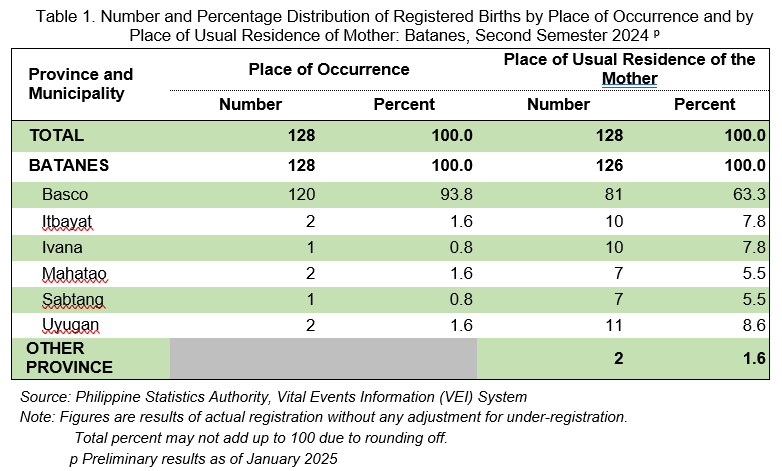
In terms of changes, the municipality of Basco registered the highest increase with an addition of six births from 114 births in the second semester of 2023 to 120 births in the second semester of 2024.
Conversely, Sabtang recorded the biggest decline, with only one birth in the second semester of 2024 compared to five births in the second semester of 2023, reflecting a decrease of four births. The municipality of Mahatao maintained their figures, with no changes in the number of registered births between the two periods.
(Figure 1 and Table 2)

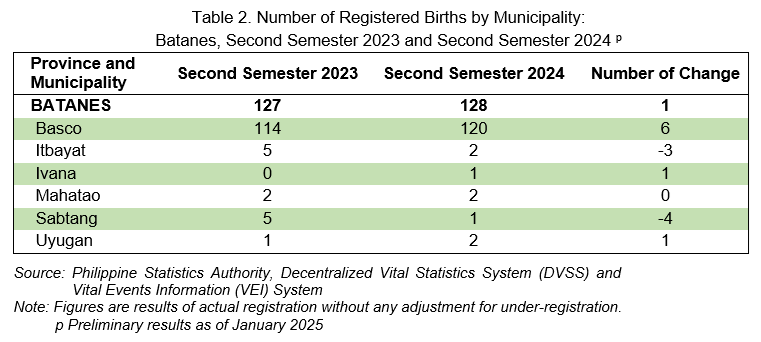
Most births were registered in November
Most births in the second semester of 2024 were registered in November with 33 births or 25.8 percent. The least number of registered births were recorded in October with 13 births or 10.2 percent. On the other hand, in the second semester of 2023, most births were registered in September, which had 33 births or 26.0 percent while least births were registered in the month of June with 13 births or 10.2 percent.
Among the months, November showed the highest increase with an addition of 11 births in the second semester of 2024 to the 22 births recorded in the second semester of 2023. Conversely, October had the biggest decline, with only 13 births in the second semester of 2024 compared to 22 births in the second semester of 2023, showing a decrease of nine births. (Figure 2 and Table 3)

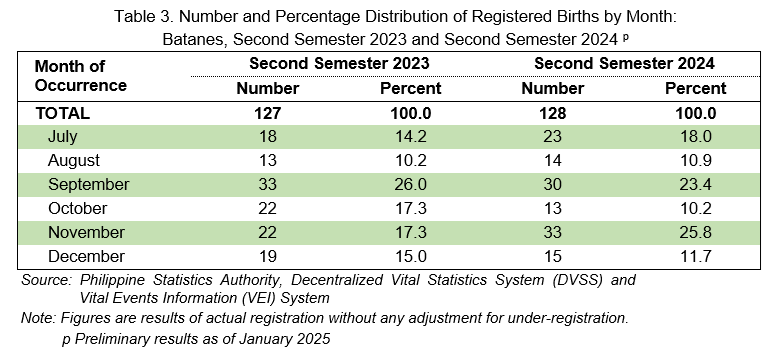
Most babies were born of unmarried mothers
Out of the 128 registered births in the second semester of 2024, 61.7 percent or 79 births were born "out of wedlock," while only 38.3 percent or 49 births were legitimate. This indicates that a higher proportion of births were registered as illegitimate compared to legitimate ones. (Figure 3 and Table 4)
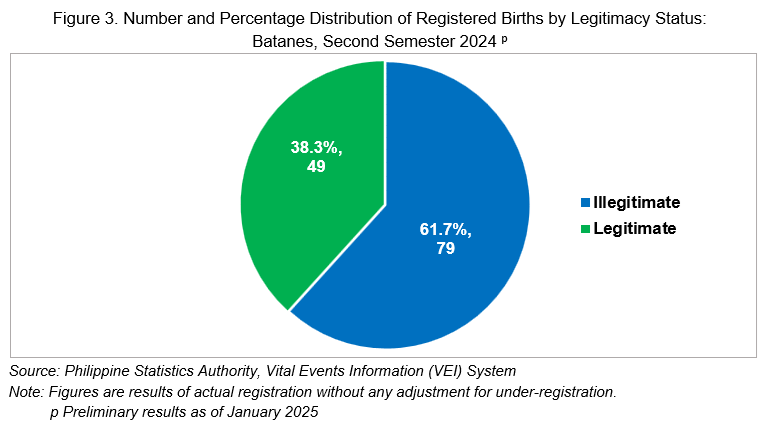

More female births were registered than male births
In the second semester of 2024, more female births were registered than male births. There were 69 female births or 53.9 percent of the total, while male births recorded 46.1 percent or 59 births. (Figure 4 and Table 5)


The sex distribution of births in Batanes showed variations between the place of occurrence and the place of usual residence across municipalities. In Basco, more females were born by place of occurrence with 65 births compared to 55 male births, and the same trend was observed in the place of usual residence of the mother, with 44 females and 37 males.
Moreover, both Ivana and Sabtang had no male births by place of occurrence and only one female birth each. Registered births, whose mothers were residing outside the province recorded two male births while no female birth. (Table 6)
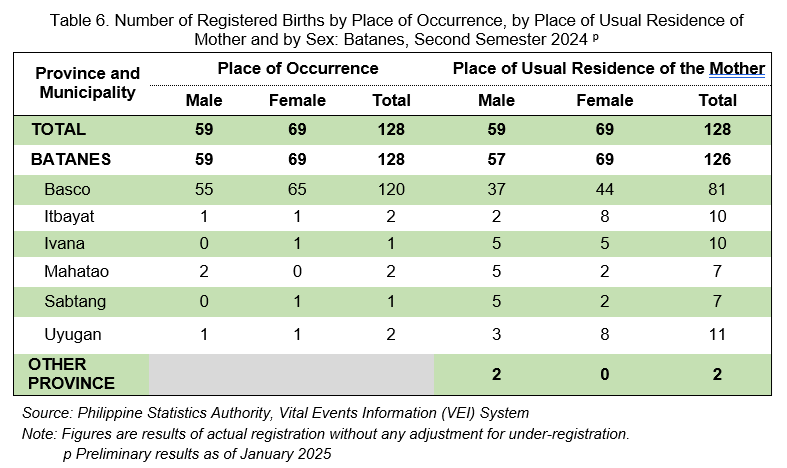
Most births were registered on time
In terms of timeliness of registration, 96.1 percent or 123 births were registered on time in the second semester of 2024, while the remaining 3.9 percent or five births were registered late. (Figure 5 and Table 7)
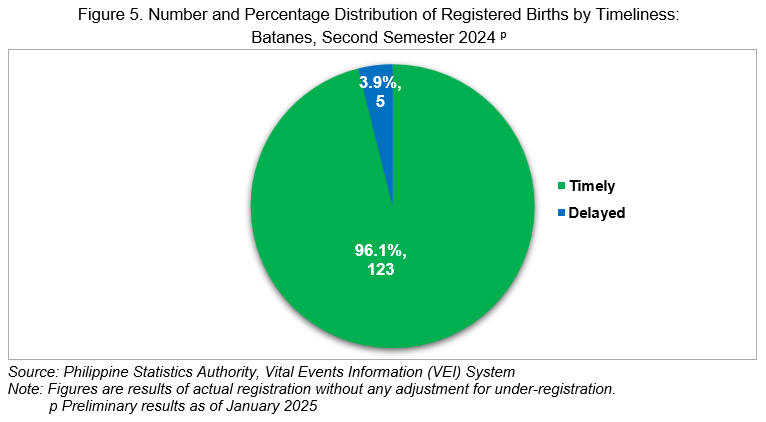

Most mothers gave birth at ages 25 to 34 years old
The distribution of registered births by age group of mothers in Batanes shows that the highest number of births occurred among mothers aged 25 to 29 years old and 30 to 34 years old, with 35 births or 27.3 percent each. Meanwhile, the least registered births were recorded among mothers aged 40 to 44 years old with six births or 4.7 percent. In addition, there was one birth or 0.8 percent registered under unknown age due to late registration.
(Figure 6 and Table 8)

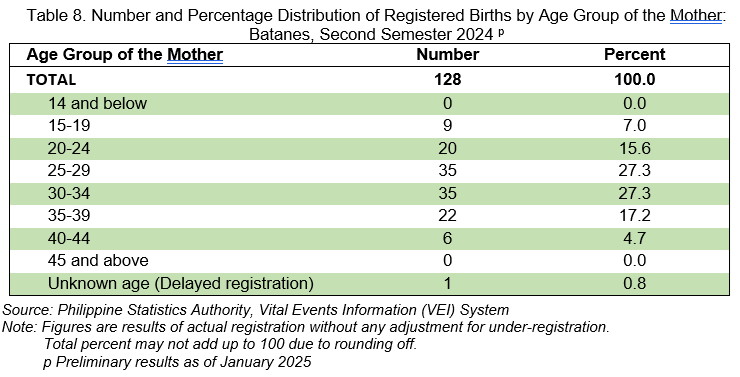
The comparison between the place of occurrence and the place of usual residence of the mother reveals key trends. Basco consistently recorded the highest number of births in both categories, with 75 illegitimate and 45 legitimate births by place of occurrence. In terms of usual residence, Basco also leads with 50 illegitimate and 31 legitimate births.
Conversely, both Ivana and Sabtang had the lowest number of births in both categories, with each had one illegitimate and no legitimate birth by place of occurrence. However, in terms of usual residence of the mother, higher figures were recorded with four legitimate and six illegitimate births for Ivana while three legitimate and four illegitimate births for Sabtang.
In terms of age distribution by place of occurrence, the municipality of Basco recorded the highest number of both legitimate and illegitimate births. Mothers aged 30 to 34 years old had the most legitimate births with 15 births while mothers aged 25 to 29 years old had the most illegitimate births with 21 births.
Similarly, in terms of the usual place of residence of the mother, Basco also recorded the highest number of both legitimate and illegitimate births. Most legitimate births were from mothers aged 30 to 34 years old with 10 births, while the most illegitimate births were from mothers aged 20 to 24 years old and 25 to 29 years old with 13 births each.
Moreover, mothers residing outside the province recorded one legitimate birth in the age group 20 to 29 years old and one illegitimate birth in the age group 30 to 34 years old.
(Table 9 and Table 10)
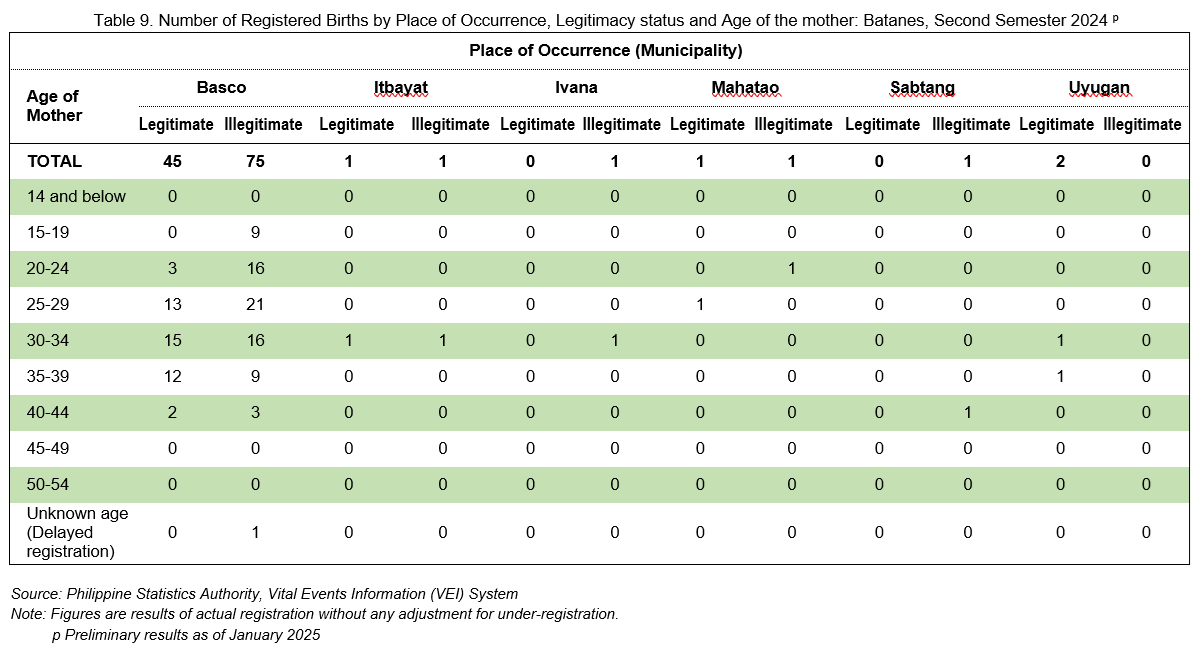

Most newborns had a birth weight of 2,500 grams or above
Birth weight serves as a measure of the nutritional status of newborns. Low birth weight is defined by the World Health Organization (WHO) as weight at birth less than 2,500 grams (5.5 lbs.).
Of the total number of 128 birth registrations in the second semester of 2024, 108 babies or 84.4 percent were recorded above the defined low birth weight, indicating that most babies were born with normal weight. Meanwhile, 18 babies or 14.0 percent were born with weights below 2,500 grams. Moreover, there were two babies or 1.6 percent whose weights were not stated due to late registration. (Figure 7 and Table 11)
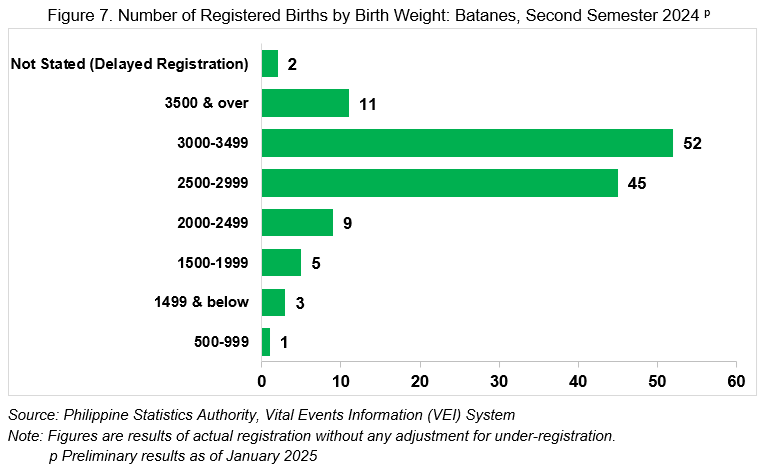
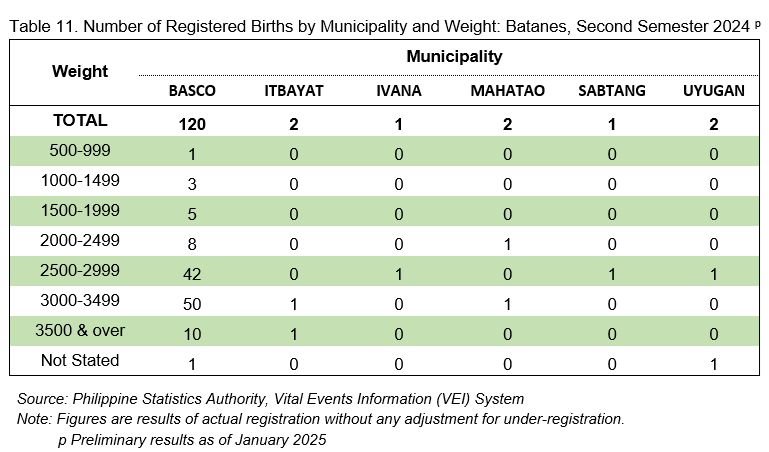
Most registered births were attended by health professionals
In the second semester of 2024, out of the 128 registered births, 123 births or 96.1 percent were attended by health professionals, which may include a physician, midwife, or nurse. Most births delivered with the assistance of health professionals were registered in Basco with 119 births by place of occurrence and 80 births by usual residence. Moreover, Basco registered two births whose mothers were residing outside the province.
Meanwhile, there were 5 late registered births or 3.9 percent which were attended by traditional birth attendants or “hilot” and others. Both Mahatao and Uyugan had the highest number of births attended by traditional birth attendants with two births each in both place of occurrence and usual residence of the mother. (Figure 8 and Table 12)
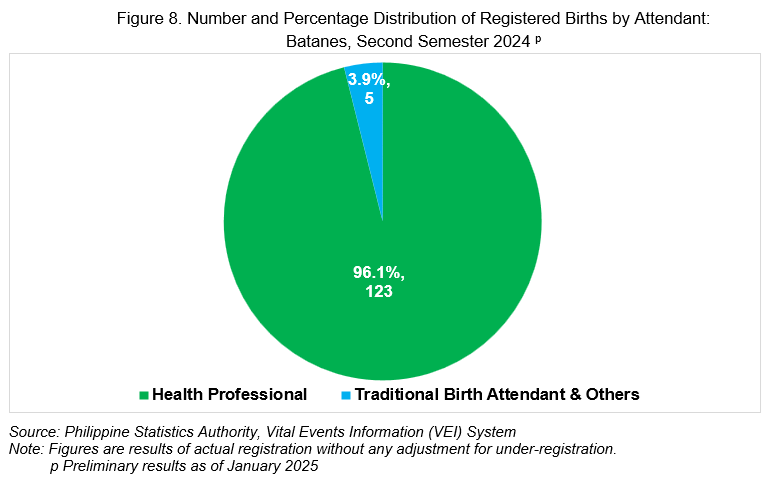
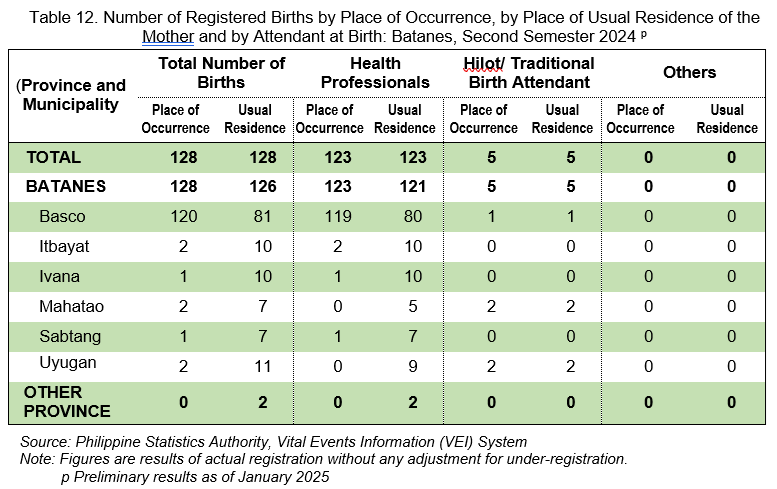
Most registered births were first-born babies
The distribution of registered births by birth order for the second semester of 2024 shows that the highest number of births was recorded for first-born children, with 42 births or 32.8 percent
In contrast, the lowest number of births was recorded for sixth-born children with only one birth representing 0.8 percent. No births were registered for seventh, ninth, or tenth and above birth orders. (Figure 9 and Table 13)
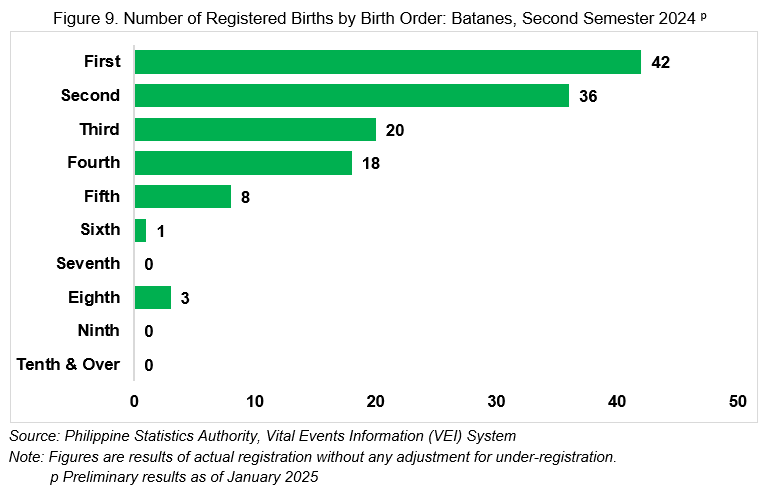
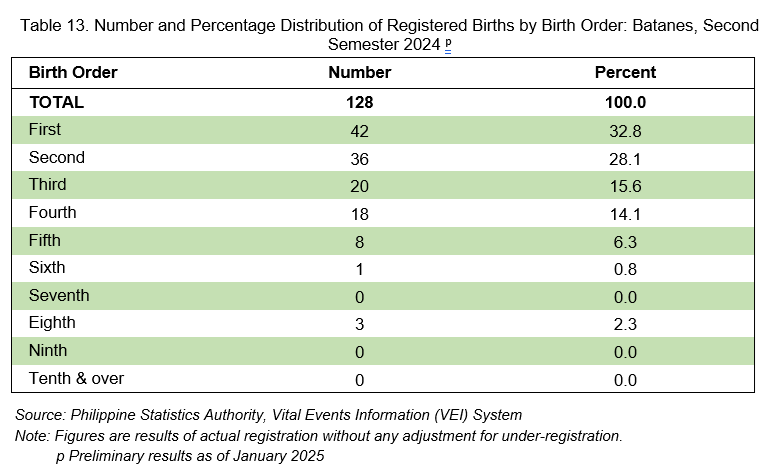
EXPLANATORY NOTES
Vital Statistics are derived from information obtained at the time when the occurrences of vital events and their characteristics are inscribed in a civil register.
The data on vital statistics presented in this release were obtained from the Certificates of Live Birth (Municipal Form 102) that were registered, either timely or delayed, at the Office of the Municipal Civil Registrars and subsequently submitted for encoding to the Office of the Civil Registrar General through the Provincial Statistical Offices (PSOs) of the Philippine Statistics Authority (PSA). The information presented includes provisional vital events that occurred from July 2024 to December 2024 based on data files received by the PSA – Batanes Provincial Statistical Office. Thus, the figures presented herein are still preliminary and may differ from the final count.
DEFINITION OF TERMS AND CONCEPTS
Birth is a complete expulsion or extraction from its mother of a product of conception, irrespective of the duration of the pregnancy, which after such separation, breathes or shows any other evidence of life, such as beating of the heart, pulsation of the umbilical cord, or definite movement of voluntary muscles, whether or not the umbilical cord has been cut or the placenta is attached; each product of such a birth is considered live born.
Place of Occurrence refers to the place where the vital event took place.
RAMIL G. ABAD, MBA, MPopS
Chief Statistical Specialist
//GVGJr
